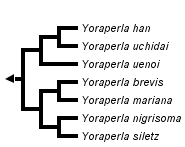Yoraperla
C. Riley Nelson


This tree diagram shows the relationships between several groups of organisms.
The root of the current tree connects the organisms featured in this tree to their containing group and the rest of the Tree of Life. The basal branching point in the tree represents the ancestor of the other groups in the tree. This ancestor diversified over time into several descendent subgroups, which are represented as internal nodes and terminal taxa to the right.

You can click on the root to travel down the Tree of Life all the way to the root of all Life, and you can click on the names of descendent subgroups to travel up the Tree of Life all the way to individual species.
For more information on ToL tree formatting, please see Interpreting the Tree or Classification. To learn more about phylogenetic trees, please visit our Phylogenetic Biology pages.
close boxIntroduction
Yoraperla Ricker includes 4 nearctic and 3 oriental species. The nearctic species form a monophyletic clade distinct from the monophyletic oriental species. This distribution is consistent with the hypothesis of clades isolated by an increase in sea level in the Bering Straits. Yoraperla probably arose in the Sierra Nevada of North America and migrated to east Asia along an inland route which included the Rocky Mountains.
Characteristics
Synapomorphies for Yoraperla: 1. Egg wafer shaped. 2. Nymph with pronotal setal rows. 3. Nymph with femoral bristles. 4. Female with lateral bars on subgenital plate. 5. Adult body size is small.
References
Stark, B. P. and C. R. Nelson. 1994. Systematics, phylogeny, and zoogeography of genus Yoraperla (Plecoptera: Peltoperlidae). Entomol. Scandinavica 25: 242-273.
About This Page
C. Riley Nelson

Brigham Young University, Provo, Utah, USA
Page copyright © 1996
All Rights Reserved.
Citing this page:
Nelson, C. Riley. 1996. Yoraperla. Version 01 January 1996 (under construction). http://tolweb.org/Yoraperla/14215/1996.01.01 in The Tree of Life Web Project, http://tolweb.org/





 Go to quick links
Go to quick search
Go to navigation for this section of the ToL site
Go to detailed links for the ToL site
Go to quick links
Go to quick search
Go to navigation for this section of the ToL site
Go to detailed links for the ToL site